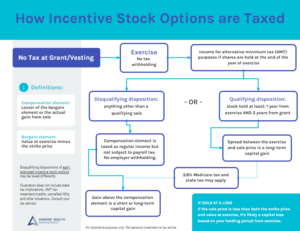The Secure Act was signed into law on December 20th, 2019, solidifying the most significant changes to the retirement system in over a decade. Though clarification on some of the finer points of the legislation will be needed from the IRS, there is plenty we already know about the Secure Act. Potential planning opportunities in light of these changes should be reviewed, so be sure to work with your wealth advisor or contact us to discuss your situation. Here are seven ways the new legislation will impact your retirement accounts, inheritance, student loans, and more.

7 Ways the Secure Act Can Impact Your Finances
-
The required minimum distribution (RMD) age increases from 70 1/2 to 72
-
Non-spouse beneficiaries must take inherited retirement funds in 10 years
-
Expect more annuities in 401(k) plans following lift on due diligence requirements for employers and plan fiduciaries
- Age limit lifted on traditional IRA contributions
- 529 plan withdrawals for student loan debt repayment, apprenticeship programs
- Penalty-free withdrawals from retirement accounts for new parents
-
Expanded 401(k) access for small businesses and part-time workers
1. The required minimum distribution (RMD) age increases from 70 1/2 to 72
Right now, investors must generally begin tapping 401(k)s, all non-Roth IRAs, 403(b)s, and Roth 401(k)s at age 70 1/2, regardless of whether the need the funds or not. The Secure Act increased the required minimum distribution (RMD) age to 72. The new law will impact retirees who have not reached age 70 1/2 by the end of 2019.
Put another way, individuals born on or before June 30th,1949 will need to start required minimum distributions at age 70 1/2 while investors who are born on or after July 1st 1949 will be required to take RMDs starting at age 72. (In practice, the first RMD can be deferred until April 1st of the year following the year you turn age 70 1/2 or 72. Subsequent RMDs must be taken by 12/31 for every year thereafter, and if you choose to defer the first RMD until April, you will need to take another RMD by 12/31.)
Also in the works are changes to the IRS’ uniform lifetime table, which is expected to be released in 2020 and take effect in 2021. Investors must use this table to figure out the denominator for their RMD calculation each year.
These changes are an effort to account for current life expectancies, but they won’t impact all investors equally. Investors who are typically hurt the most by required minimum distributions are wealthier individuals with large tax-deferred accounts.
Given this and the other changes in the legislation, now is the time many individuals may want to consider changes to their withdrawal strategy and adding tax-diversification with Roth IRA conversions and/or a brokerage account. If you’re charitably inclined and looking for ways to reduce your taxable income before or after your required minimum distribution age, you may wish to consider donor-advised funds or qualified charitable distributions right from your IRA. Note that as of now, the law allowing qualified charitable distributions from an IRA after age 70 1/2 did not change, even though the RMD age did.
Though the QCD limit remains $100,000 per taxpayer, per year, if an individual makes a tax-deductible IRA contribution and a qualified charitable distribution in the same year, the amount of the QCD is decreased by the amount of the deductible IRA contribution.
Of course, legislative changes impacting tax rates or provisions to other account types can’t be ruled out in the future, but for now, some investors have more time to plan for the RMD tax cliff.
Read: Should You Wait Until Age 72 to Take RMDs?
2. Non-spouse beneficiaries must take inherited retirement funds in 10 years
Currently, most non-spouse beneficiaries who inherit any type of IRA, 401(k), or other type of defined contribution plan can choose to withdraw the funds by taking required minimum distributions over their life, based on their age in the IRS’ uniform lifetime table. This is commonly called a ‘stretch IRA’.
To help fund the other provisions of the Secure Act, the legislation no longer allows beneficiaries who inherit a retirement account from a non-spouse (e.g. parent or relative) to take distributions over their lifetime if the decedent passed away after 2019. Starting in 2020, these inheritances will now need to be depleted in 10 years.
This could mean a series of significant tax events for high earning working adults as required minimum distributions will be included in their taxable income for the year (except for Roth IRAs). After-tax proceeds can be reinvested in a brokerage account, but the accelerated recognition of taxable income (taxed at the highest marginal tax rate) and loss of tax-deferred growth is very significant. Non-spouse beneficiaries cannot convert an inherited IRA to a Roth IRA, so there’s no way to maintain tax-deferred growth even after recognizing the income.
Forcing annual cash injections will likely encourage lifestyle spending during for beneficiaries during the payout period, which may become unsustainable when the money is gone. It will leave fewer dollars available for reinvestment for long-term financial goals.
For account owners looking for ways to provide a prolonged payout to heirs, some planning opportunities may include a Roth conversion, putting taxable assets in a revocable trust to receive step-up in cost basis, or a charitable remainder trust. Keep in mind, these strategies could also fall victim of new legislation in the future, with or without grandfathering. So it’s important to weigh your goals with the risks and opportunities.
(Note: there are three exceptions to the 10-year non-spouse distribution rule: minor beneficiaries will have until they reach the age of majority (age 18 in most states) before the 10-year period begins; beneficiaries less than 10 years younger than the decedent can take distributions over their life as can disabled beneficiaries).
In light of these changes, it’s wise to consider reviewing your estate plan, particularly if you’ve named a trust as a beneficiary of an IRA or retirement account.
Read: What the End of the Stretch IRA Means for Your Estate Plan
3. Expect more annuities in 401(k) plans following lift on due diligence requirements for employers and plan fiduciaries
Following a BIG win for the mighty insurance industry, new annuity options are expected to flow into 401(k) plans. Previously, employers and plan fiduciaries would be required to do an in-depth due diligence review of an insurer before offering an annuity product in a 401(k) plan. Under the Secure Act:
“Under the bill, fiduciaries are afforded an optional safe harbor to satisfy the prudence requirement with respect to the selection of insurers for a guaranteed retirement income contract and are protected from liability for any losses that may result to the participant or beneficiary due to an insurer’s inability in the future to satisfy its financial obligations under the terms of the contract.” [Emphasis added]
The legislation means that the employer cannot be held liable if the insurance company becomes insolvent and can’t meet their financial obligations (e.g. pay you an expected income stream). While the employer still maintains a fiduciary duty in picking the products themselves (fees, suitability), the new legislation significantly reduces their risk in offering annuity products, many of which carry a much higher cost to the investor than other investment options in the plan, like mutual funds and ETFs.
The legislation effectively leaves employees with the risk and onerous analysis to determine whether the product is truly a suitable investment based on the financial health of the insurer and the cost of the product, which reduces investment returns.
While simple fixed, low(er) cost annuities may very well have a place in the modern retirement plan investment menu, particularly for low-to-mid-income investors who may need options in addition to Social Security to ensure they can continue to meet basic expenses on a limited fixed income. However, this legislation opens a big window to the myriad of high-cost and complex annuities that make the big bucks for the insurers and annuity salespeople alike.
4. Age limit lifted on traditional IRA contributions
Currently, individuals over age 70 1/2 cannot make contributions to a traditional IRA. Starting in 2020, individuals with earned income can make contributions up to the annual limit. This is consistent with active 401(k) participants and Roth IRAs.
IRA contributions may still be non-deductible if you’re above the annual income limits set forth by the IRS. Before making a non-deductible contribution, consider the downsides.
5. 529 plan withdrawals for student loan debt repayment, apprenticeship programs
Student loan debt
529 plans are best known as college savings plans, but in early 2018 qualified expenses expanded to private school grades K-12. Immediately following the passage of the Secure Act, qualified expenses will expand yet again to include student loan repayment and costs of an apprenticeship program.
A 529 plan beneficiary can now use up to $10,000 from a 529 plan to pay down principal and/or interest on their qualified education loan. This amount is a lifetime limit per beneficiary. Plan beneficiaries are also allowed to distribute an additional $10,000 to pay down qualified debt for each of the beneficiary’s siblings. While not a huge amount in dollar terms given average debt balances, this could be helpful for families in certain situations. For example, it’s possible to have leftover 529 plan funds and one or more children with debt if a younger child received a scholarship, lived at home, went to a less expensive school, didn’t attend college, or was saving funds for grad school and plans changed.
Apprenticeship program costs
The Act expanded qualified education expenses for 529 plan withdrawals to include the cost of apprenticeship programs, such as a trade school for skilled labor. Not every kid goes to college and they don’t have to in order to make an excellent living – very successful tradespeople in top markets can make hundreds of thousands of dollars a year running their business. There’s a reason for the saying “you never see a poor plumber”!
6. Penalty-free withdrawals from retirement accounts for new parents
New parents can now withdraw up to $5,000 from their 401(k), IRA, or other defined contribution plan within a year after they give birth or adopt a child without incurring the 10% penalty. Taxes on investment gains would be due that year as the distribution would be included in your taxable income.
Note that this is not a loan and while the money can be repaid, it isn’t required. Technically, each spouse can take out $5,000 from their accounts for a total of $10,000. While it’s nice to have options, tapping retirement accounts so early in life can really hurt your savings trajectory.
7. Expanded 401(k) access for small businesses and part-time workers
Part-time eligibility
The Secure Act will expand employee eligibility requirements favorably for part-time employees. In 2019, employers could prevent part-time workers from becoming eligible to participate in the 401(k) plan if the individual worked less than 1,000 hours during the year (essentially precluding anyone working less than an average of 20 hours per week, assuming 2 weeks for vacation).
Effective for plan years starting in January 2021, employers will need to expand the eligibility requirements to include part-time employees who have worked at least 500 hours per year for the last three years (consecutively). The three-year lookback period will only apply to hours worked after January 1st 2021, meaning long-term part-time workers who meet this eligibility criteria could contribute starting in 2024.
For employers who have newly-eligible employees under the three-year rule, they will not be required to include those individuals in annual nondiscrimination and top-heavy tests. Current legislation also suggests that employers won’t be required to make matching, profit-sharing, or Safe Harbor contributions to the accounts of long-term, part-time part employees.
Multiple-employer 401(k) plans
Allowing unrelated employers to join together to offer a 401(k) plan to their employees is another major change included in the Secure Act. Under the Act, starting in 2021, multiple companies (typically small employers) can band together to share the costs and administrative burden of offering retirement plan benefits to workers. How exactly this will work in practice will need to be fleshed out. Further, multiple-employer plans (MEPs) will have their share of challenges and limitations.
The most affordable MEPs will likely require employers to pick from an ‘out-of-the-box’ plan design (eligibility requirements, matching, vesting, loan provisions, etc.) and investment options. Further customization will increase costs. MEPs will still need to satisfy annual testing requirements, and depending on the make-up of the participants, could become top heavy or fail nondiscrimination testing. Employers also cannot outsource all administration requirements – they’ll still need to remit payroll contributions, monitor loans and deferral changes.
Credits for small businesses starting new 401(k) plans
Starting in 2020 and for the next two tax years, small employers may be eligible to receive a credit between $500 – $5,000 to help offset the costs of starting a new 401(k) plan. An eligible employer is considered to have no more than 100 employees who was paid at least $5,000 from the employer for the preceding year.
The credit is limited to the greater of (1) $500 or (2) the lesser of (a) $250 multiplied by the number of
non-highly compensated employees of the eligible employer who are eligible to participate in the plan or
(b) $5,000.
Automatic enrollment credit for small businesses
Small businesses meeting the same eligibility requirements as above may also be entitled to a $500 credit for three tax years starting in 2020 for starting a new 401(k) plan or SIMPLE IRA that includes automatic enrollment provisions or converting an existing plan to include this feature. This credit is available in addition to the start-up cost credit.
Deadline to establish new qualified retirement plans extended
The current deadline to establish a new qualified retirement plan is December 31st to be considered for that year. Under the Secure Act, employers can establish a new qualified retirement plan, such as a 401(k) or 403(b) as late as the corporate tax filing deadline. While the extension won’t impact individual contributions, which must be made before the end of the year, it would permit employers to make a profit-sharing contribution to employee accounts for the previous tax year.











